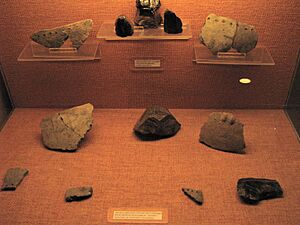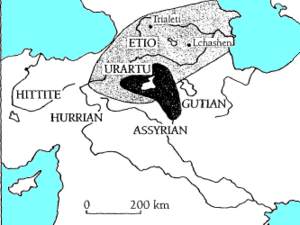Kura–Araxes culture facts for kids
| Geographical range | South Caucasus, Armenian Highlands, North Caucasus |
|---|---|
| Period | Bronze Age |
| Dates | circa 3,400 B.C.E. — circa 2,000 B.C.E. |
| Major sites | Shengavit |
| Preceded by | Shulaveri-Shomu culture |
| Followed by | Trialeti-Vanadzor culture, Nakhchivan culture |
The Kura–Araxes culture was an ancient civilization that lived from about 4000 BC to 2000 BC. It is also known as the Kur–Araz culture or Early Transcaucasian culture. The first signs of this culture were found in the Ararat plain. By 3000 BC, it had spread north into the Caucasus mountains.
This culture covered a huge area, about 1,000 kilometers long and 500 kilometers wide. It included most of the South Caucasus (except western Georgia), parts of northwestern Iran, the northeastern North Caucasus, eastern Turkey, and even reached Syria. The culture gets its name from the Kura and Araxes river valleys, where it first appeared. Some local versions of the Kura–Araxes culture are called Shengavitian or Karaz cultures. This culture later led to the Khirbet Kerak-ware culture in the Levant and the Trialeti-Vanadzor culture in the South Caucasus. In the Nakhchivan region, the Kura-Araxes culture was followed by the Nakhchivan culture.
Contents
How the Kura-Araxes Culture Began
Before the Kura–Araxes culture, the Shulaveri-Shomu culture lived in the same area. These two cultures were quite different, so it was not clear how they were connected. Later, experts thought that the Sioni culture in eastern Georgia might have been a link between the Shulaveri and Kura-Araxes cultures.
At many old sites, layers from the Sioni culture are found between the Shulaveri-Shomu and Kura-Araxes layers. This suggests the Sioni culture existed around 4000 BCE. Some scholars believe that the Kartli and Kakheti areas were key to the very first phase of the Kura–Araxes culture. It seems to have been a local culture of the Caucasus that grew over time, also taking in ideas from other places.
There are signs that the Kura-Araxes and Uruk cultures existed at the same time, especially at a place called Arslantepe. These connections might have started even earlier. Some experts think the Kura-Araxes culture might have begun as early as the late 5th millennium BC. This idea comes from new findings at Ovçular Tepesi in Nakhchivan.
How the Culture Spread
The Kura–Araxes culture quickly began to spread. It moved west towards the Erzurum plain, southwest into Cilicia, and southeast into the areas around Lake Van and Lake Urmia in Iran. It eventually reached modern-day Syria and even Palestine.
The territory of this culture covered large parts of modern Armenia, Azerbaijan, Chechnya, Dagestan, Georgia, Ingushetia, North Ossetia, and parts of Iran and Turkey.
At a site called Sos Hoyuk in Turkey, early Kura-Araxes pottery was found alongside local pottery from as early as 3500-3300 BC. This shows that the settlement was part of the Kura-Araxes culture during the Early Bronze Age (3000-2200 BC). At Arslantepe in Turkey, around 3000 BCE, there was a lot of burning and destruction. After this, Kura-Araxes pottery started to appear in the area.
Some experts, like Geoffrey Summers, believe that the Kura-Araxes people moved into Iran and the Van region quite suddenly. This might have happened just before 3000 BC, possibly because of the 'Late Uruk Collapse' around 3100 BC.
Daily Life and Achievements
The Kura–Araxes culture was connected to the Maykop culture in the North Caucasus, which existed around the same time. It seems these two cultures influenced each other.
Economy and Farming
The people of the Kura-Araxes culture mainly made their living through farming and raising livestock. They especially raised cattle and sheep. They grew grains and fruit trees, and they used tools to make flour. Besides cattle, sheep, and goats, they also had dogs. In later times, they started raising horses. Before the Kura-Araxes period, horse bones were not found in this region. But after about 3300 BCE, horses became common, and there were signs they were being tamed.
There is also proof that they traded with people in Mesopotamia and Asia Minor. However, the Kura-Araxes culture is mostly seen as a local culture of the Caucasus. Its main features influenced later important cultures in the region.
Settlements and Homes
Archaeological findings show that Kura–Araxes settlements were often built along the Hrazdan river. Drawings in a nearby cave also show their presence in mountainous areas. The houses in their settlements did not show much difference in size or style. This suggests that for a long time, their society probably did not have a strong social hierarchy. Some, but not all, settlements were surrounded by stone walls. They built houses from mud-bricks. At first, these houses were round, but later they became more rectangular. Some had one or two rooms, others had multiple rooms around an open space.
At some point, their settlements and burial grounds expanded from river valleys into higher mountain areas. Some scholars thought this meant they switched from farming to raising animals, and that it might show a large group of Indo-Europeans arriving. However, settlements in the lowlands continued, which suggests the people were just adding more ways to get food, like raising both crops and livestock.
Shengavit Settlement is a very important Kura-Araxes site in modern-day Yerevan, Armenia. People lived there from about 3200 BC to 2500 BC. Later, it was used off and on until 2200 BC. The town was quite large for a Kura-Araxes site, covering six hectares.
Metalwork
In the very early days of the Kura–Araxes culture, metal was rare. The culture that came before it, the Leilatepe culture, actually had more advanced metalwork.
However, the Kura–Araxes culture later became very skilled in metalworking. This skill strongly influenced the areas around them. They worked with copper, arsenic, silver, gold, tin, and bronze. Their metal goods were traded far and wide. They reached from the Volga, Dnieper, and Don-Donets rivers in the north, to Syria and Palestine in the south, and Anatolia in the west.
Pottery
Their pottery was very special. It was painted black and red, often with geometric patterns. This pottery spread along trade routes to many surrounding cultures. Examples have been found as far south as Syria and Israel, and as far north as Dagestan and Chechnya. The wide spread of this pottery, along with signs of invasions, suggests that the Kura-Araxes people might have moved out from their original homes. They certainly had many trade connections. Some experts believe its spread south was mainly due to the Mitanni and Hurrians.
According to Giulio Palumbi (2008), the typical red-black pottery of the Kura–Araxes culture first appeared in eastern Anatolia. Then it moved to the Caucasus area. But later, these cultural ideas came back to Anatolia mixed with other cultural elements from the Caucasus.
Wine-Making
Viticulture (growing grapes) and wine-making were very common in this area from ancient times. Grape growing even goes back to the earlier Shulaveri-Shomu culture.
The oldest evidence of tamed grapes in the world has been found at Gadachrili Gora in southeastern Republic of Georgia. Carbon dating shows these grapes are from about 6000 BC. Grape seeds from the 5th and 4th millennia BC were found in Shulaveri and Khizanaant Gora, both in the same 'Shulaveri area' of Georgia.
One idea is that the Kura-Araxes people might have spread the Vitis vinifera vine and wine-making skills to the "Fertile Crescent"—to Mesopotamia and the Eastern Mediterranean. The spread of the wine-goblet shape, like the Khirbet Kerak pottery, is clearly linked to these people. The same goes for the large ceramic pots they used to ferment grapes.
Burial Customs
The Kura-Araxes people had different ways of burying their dead. They used flat graves, but also large kurgan burials. Kurgans are burial mounds, and some were surrounded by stone circles called dolmens. This suggests that the population might have been made up of different groups of people.
T. A. Akhundov noted that the burial sites from the Kura-Araxes period were not all the same. This is unusual for a single culture, because burial customs usually show deep cultural beliefs. There were burials without kurgans and with kurgans. Some were in pits in the ground, others in stone boxes or crypts. They used both round and rectangular burial shapes. There were also big differences in how the bodies were placed. Sometimes, Kura–Araxes burial sites even included cremation.
This suggests that the Kura–Araxes culture grew slowly by combining several cultural traditions. These included ancient cultures from the Caucasus and nearby areas.
Later Kura-Araxes sites often had kurgans of many different sizes. Larger, richer kurgans were surrounded by smaller ones that had less wealth. These kurgans also contained many different metal objects. This trend suggests that a clear social hierarchy eventually developed. Their custom of putting a lot of wealth in burial kurgans was probably an idea they got from the older civilizations of the Fertile Crescent to the south.
In the 3rd millennium B.C., a special group of Kura–Araxes burial mounds stands out because of how rich they were. This was during the final stage of the culture's development. These burial mounds are known as the Martqopi (or Martkopi) period mounds. Those on the left bank of the Alazani river are often 20–25 meters high and 200–300 meters wide. They contain especially valuable items, such as gold and silver jewelry.
Languages Spoken
We don't know for sure what languages were spoken in the Kura-Araxes culture. The two most common ideas suggest a link to Hurro-Urartian languages or Anatolian languages. It is also likely that Kartvelian and Northeast Caucasian languages were spoken in the region.
See also
 In Spanish: Cultura Kurá-Araxes para niños
In Spanish: Cultura Kurá-Araxes para niños
- Leyla-Tepe culture
- Prehistoric Armenia
- Prehistoric Azerbaijan
- Prehistoric Georgia
- Aşağımollahasan höyük




